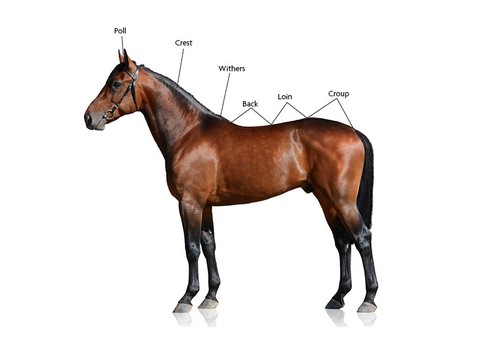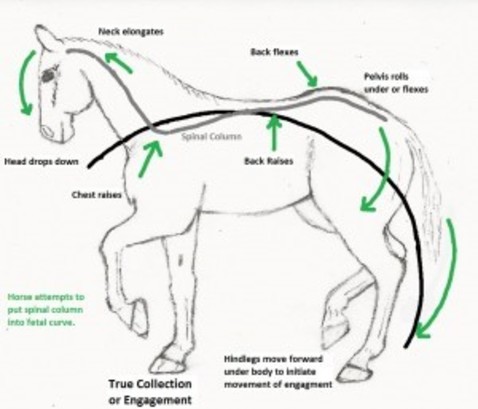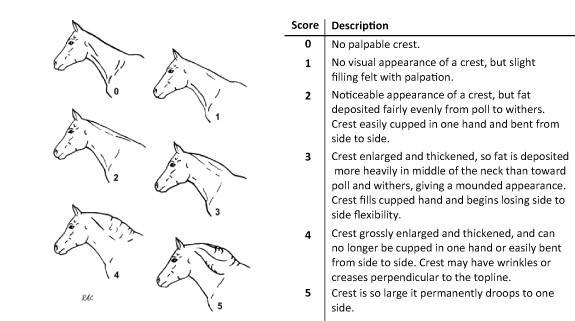Horse owners and riders are constantly striving to achieve a fantastic topline but this is very rarely easy. Your horse will require a good quality, balanced diet and the correct exercise. One without the other will not produce the desired results!
It is often thought that topline refers to simply the muscles in the neck, but actually, it involves much more than this. Your horse’s topline includes all the musculature that runs from the poll, down the horse’s neck, over the back and into the hindquarters.

In order for your horse’s topline to improve it is important that they are working these muscles correctly. Your horse does not simply need to work with the head down and “on the bit”, rather it requires synchronized action of multiple groups of muscles to raise the back and lift the spine. The diagram below demonstrates how horses work when they are truly engaged:

If your horse is not moving correctly it can cause unwanted compensatory muscle growth in other areas; working against developing the topline properly.
Topline will not develop instantly and is one of the last qualities to develop in the equine athlete; taking longer in some horses than others depending on their conformation. Keep working on your horse’s way of going and you will get there in time!
We’ve been speaking to Veterinary Physiotherapist, Georgina White, who has given us some fantastic tips to help improve your horse’s topline:
Work on leg yield – this can be done in the school, or even whilst out hacking
Practice shoulder-in on a circle with lots of transitions
Long reining your horse is an excellent way to improve straightness and independence of aids.
Pole work is a brilliant exercise as it asks your horse to lift through their spine and epaxial muscles to clear the poles. Here are some ideas:
o Set out the poles in a fan, as this will make the epaxial and core muscles work hard to lift and bend round a circle. The limb on the outside of the circle works harder to cover more ground. Remember to work your horse equally on both reins to challenge the left and right sides of their body.
o Remember walking over poles is just as beneficial as trot and canter- the horse is not assisted by the momentum generated by the symmetrical gait pattern of trot.
o Pole work in-hand is also beneficial, working the cardiovascular system harder will not always mean that your horse’s topline will improve quicker!
As mentioned previously, it goes without saying that your horse will need the correct nutrients to support their work.
To help your horse build up muscle it is important that we provide them with high-quality protein. The amount of protein that your horse needs depends on many factors including their age, workload and work type. If you feed high levels of protein when your horse does not require it, they will break down the excess and it will be excreted in the urine. Getting the right balance is therefore essential.
It is not simply the amount of protein that matters, the quality of protein provided is just as important. Proteins are made up of amino acids, of which there are 21 different types. The horse can make some of these themselves, but others have to be supplied in the diet. Lysine is very important as it is usually the first amino acid to limit muscle development. Performance feeds often contain ingredients naturally higher in lysine or may have added lysine to support horses in hard work. For horses in harder-work, the protein supplied in grass, hay or haylage may not be sufficient. Feeding a performance-level feed will likely be supplying quality protein at the correct quantities. If your horse is a good doer a high specification balancer will provide your horse with the high-quality protein that they require without unwanted weight gain.
It is also important to supply your horse with a fully balanced diet providing a broad spectrum of vitamins and minerals. This can be done by feeding a compound feed, balancer, or vitamin and mineral supplement at recommended amounts.
Finally, be careful to spot the difference between fat and topline. Some horses with a cresty neck may look as though they have a topline, but this is not the case! You should be able to feel the difference between muscle and fat deposits as the muscle will feel more rigid, whereas fat is often softer and lumpy. It is worth noting that some horses can have very large fat deposits in the neck; the fat may feel solid but will appear very different to muscle, with masses of fat sitting directly on top of the horse’s neck. The chart below describes how to spot whether your horse has a cresty neck.

---
Image 2:
Wagner, K.L., (2016). Equine Gait Collection [online]. Available at: https://wagnerhorsedoc.com/201...
Carter, R.A., Geor, R.J., Staniar, W.B., Cubitt, T.A. and Harris, P.A., 2009. Apparent adiposity assessed by standardised scoring systems and morphometric measurements in horses and ponies. The Veterinary Journal, 179(2), pp.204-210.
Article written by Cosette Darby BSc (Hons), Dodson & Horrell Nutritional Advisor


